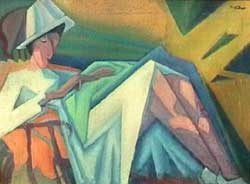Kind of bitter. Dick Beer who incidentally knew how to write, was refused a right of reply in the same newspaper. Eventually, it was the magazine Politiken (more committed) which published him. And it is with much eloquence and irony that the painter expresses the hope of getting critics to become more reasonable. In quite a long and well constructed piece, with sincerity and no vulgarity, the painter advances an explanation: that the many personal attacks made derive from the fact that he himself was not tender with the critics in his catalogue foreword. Yes, let’s admit it, Dick Beer is a fighter, a “baroudeur” as he would explain in French. “In some cases”, he wrote in his preface, “one has the feeling that the critic considers the painter to be at his disposal and not the opposite. Many are the young modernists who have aroused suspicions or are misinterpreted by a conformist critic. What can we do about it ? We should make contact directly with the public through debates, conferences, etc. It is not because one is not able to understand a work immediately that this means humbug” (he uses this exact word before Hoppe’s personal attack).

Roth in armchair
In his written reply, Dick Beer reminds Ragnar Hoppe that Ruskin, the king of British critics, went so far as to completely denigrate James McNeill Whistler (who was often seen in Beer’s childhood home in London), describing the great American artist as “an odd character amusing himself by throwing a paint can in the face of the public”. Dick Beer clearly says that Hoppe has understood nothing:
“What you in your article call the Circus canvas is entitled Toy Box in the catalogue. The logic of this painting is only apparent. And why should a painting be logical ? Think of Puvis de Chavannes’ large fresco in Lyon’s town hall. In this composition, the artist takes the liberty to neglect intrinsic values and overall consequence. Some of the 8-9 figures are lighter than the air, that was meant naturally. My Toy Box was painted with the idea of catching a certain movement. The fact that I represent persons in a naturalist way on the canvas is rather cute I think, it does not perturb the total view. Even Picasso may do so. By the way your article is full of strange statements. How do you know that [the Swedish artist] Karl Ede was influenced by Archipenko when arriving to Paris in 1913 ? I know Ede since long and may assert that, at least then, he was fully ignorant of the existence of such an individual.”
(Continued)